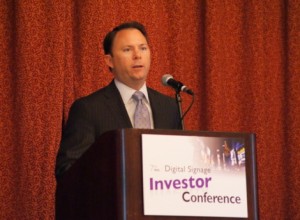Gail Chiasson, North American Editor
It seems that every time we hear Garry McGuire, CEO of RMG Networks, San Francisco, he is right on target with his talk.
 Such was the case at the Digital Signage Investor Conference in New York last week when McGuire, stepping into an unexpected gap in the program at the last minute, came up again with a speech that was filled with the type of information that attendees came to hear.
Such was the case at the Digital Signage Investor Conference in New York last week when McGuire, stepping into an unexpected gap in the program at the last minute, came up again with a speech that was filled with the type of information that attendees came to hear.
McGuire talked about what his company has done right and wrong, acquiring, developing but then selling certain networks on its way to now focusing on its networks that target the traveling business executive.
RMG is successful, earning 75% of its revenue from advertising on more than 125,000 screens and 25% from software licenses sold to other companies such as DirecTV. Much of its target audience is captive, spending an average between two and four hours watching screens in airplanes.
RMG has screens in all major airlines now. The 125,000 screens represents the installed screens within RMG’s current networks: in-flight and airport clubs. That number does not account for the ‘bring your own screen’ media model RMG leverages through its partners providing in-flight Wi-Fi connectivity and entertainment.
“We are now at a size and scale that attracts TV dollars,” said McGuire, pulling in advertising from such sectors as automotive, business-to-business technology, packaged good and more.
Looking back, RMG (originally called Danoo) bought Ideacast, which had media on airlines (Jet Blue and Continental) back 2009. It then added a pharmacy business, Pharmacy TV, followed by the Executive Media Network advertising in airport lounges in 2011. It also added a coffee shop network, spending $8 million developing technology, and also adding a fitness network.
It has now divested itself of all networks that are not directly dealing with the traveling executive and is selling to agencies as Travel Nedia. Its networks are reaching executives in airport lounges, Amtrak trains and in-flight. It sold its Fitness network to Orion Equity Holdings PLC and its Coffee Shop network to DigiCast Networks. It had earlier bundled the Pharmacy TV assets together with Pharmacy Health Network and Everwell (doctors’ offices) to create a single Point-of-Care Network, but when RMG began taking steps to focus on key demographics and network contexts, it moved away from the Point-of-Care space. Cardinal Health now owns the Pharmacy Health Network.
“For us, sound, sight and motion on our screens are important,” said McGuire. “We always try to build both awareness and engagement. And one thing we’ve learned is that if something is not working today, change it tomorrow. Don’t wait.”
RMG also has a technology company in China that it uses to power its own networks. McGuire says that the company makes sure that it has the best technology – “better than anyone else.”
“Another thing we’ve learned is that media buyers are the slowest people to adapt,” he said. “And that the time line for achieving profitability has to be faster than you think.”
Other lessons learned are that:
- It’s important to keep things simple;
- Scale is important but the audience has to be the same;
- Media buyers don’t like new things;
- Own something, and do it better than anyone else;
- Follow the money!
McGuire said that, despite the popularity of So/Lo/Mo, there are not a lot of advertising dollars in that space.
One piece of advice he gave the audience: “Tighten your inventory control.”
Whereas RMG controls almost 100% of the airlines and business lounge advertising space, it has been able to raise the prices four times in the past year. It was able to provide advertisers with better data, with solid metrics, so became a more valuable asset. (It sells advertising both by CPM and sponsor-based.)
By focusing as Travel Media, RMG added 17 new accounts in 2011 and, and, to date in 2012, it has added 44. It also has an 88% renewal rate.
It also has both Europe and Asia in its view for 2013, hoping to replicate its success in the U.S. in those markets.





October 26th, 2012 at 15:46 @698
The following portion of this post is misleading on two counts:
“It had earlier bundled the Pharmacy TV assets together with Pharmacy Health Network and Everwell (doctors’ offices) to create a single Point-of-Care Network, but when RMG began taking steps to focus on key demographics and network contexts, it moved away from the Point-of-Care space. Cardinal Health now owns the Pharmacy Health Network.”
It gives the impression that RMG had created a single network under its ownership by combining three assets. That is clearly not the case. If one were to review the press releases from August 2010 (http://www.dailydooh.com/archives/31932), RMG announced deals to represent both Everwell and Pharmacy Health Network from an ad sales perspective. It never had ownership of either network. RMG *did* own Pharmacy TV, which was never a shining star, and had significantly less scale than either Everwell or PHN. The deal allowed RMG to use the scale of the other two networks to make pitches it could not make as Pharmacy TV alone. It is probably reasonable to gauge RMG’s success in doing so by noting its subsequent actions.
Cardinal Health has always owned PHN. To imply that it “now” owns PHN after RMG left the space is misleading and factually incorrect.
October 26th, 2012 at 16:37 @734
As Gail mentioned, Garry did a great job of filling in last-minute and I look forward to an opportunity to hear another presentation from him soon.